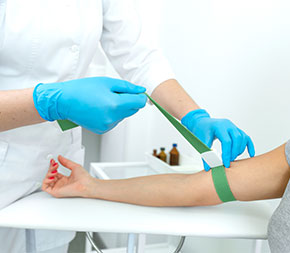The Basic Principles Of Northeast Medical Institute - New Haven Campus Phlebotomy Course & Cna Class
The Basic Principles Of Northeast Medical Institute - New Haven Campus Phlebotomy Course & Cna Class
Blog Article
Not known Details About Northeast Medical Institute - New Haven Campus Phlebotomy Course & Cna Class
Table of ContentsSome Known Details About Northeast Medical Institute - New Haven Campus Phlebotomy Course & Cna Class Some Known Factual Statements About Northeast Medical Institute - New Haven Campus Phlebotomy Course & Cna Class What Does Northeast Medical Institute - New Haven Campus Phlebotomy Course & Cna Class Mean?The 4-Minute Rule for Northeast Medical Institute - New Haven Campus Phlebotomy Course & Cna ClassRumored Buzz on Northeast Medical Institute - New Haven Campus Phlebotomy Course & Cna ClassSome Known Incorrect Statements About Northeast Medical Institute - New Haven Campus Phlebotomy Course & Cna Class
The use of such devices should be come with by various other infection prevention and control practices, and training in their use. Not all safety and security devices are appropriate to phlebotomy. Before picking a safety-engineered gadget, customers must thoroughly examine readily available tools to identify their appropriate usage, compatibility with existing phlebotomy techniques, and effectiveness in shielding team and clients (12, 33).For setups with low resources, price is a motoring element in procurement of safety-engineered devices. Where safety-engineered gadgets are not offered, competent usage of a needle and syringe is appropriate.
Among the necessary markers of high quality of care in phlebotomy is the involvement and teamwork of the individual; this is equally valuable to both the wellness worker and the patient. Clear details either created or spoken need to be available to every individual who goes through phlebotomy. Annex F provides example message for explaining the blood-sampling procedure to a patient. In the blood-sampling area for an outpatient division or center, give a comfy reclining sofa with an arm remainder.
Not known Details About Northeast Medical Institute - New Haven Campus Phlebotomy Course & Cna Class
Ensure that the indicators for blood tasting are plainly defined, either in a created protocol or in documented directions (e.g. in a research laboratory type). Collect all the tools required for the treatment and location it within safe and simple reach on a tray or cart, guaranteeing that all the items are plainly noticeable.
Where the client is adult and conscious, comply with the steps laid out listed below. Present on your own to the patient, and ask the individual to specify their full name. Inspect that the laboratory form matches the person's identification (i.e. match the individual's details with the lab type, to guarantee exact identification). Ask whether the license has allergies, phobias or has ever before collapsed during previous shots or blood attracts.
Make the patient comfortable in a supine placement (if possible). The client has a right to refuse a test at any time before the blood tasting, so it is crucial to make sure that the patient has actually understood the treatment - Phlebotomy Classes.
Northeast Medical Institute - New Haven Campus Phlebotomy Course & Cna Class for Beginners
Extend the person's arm and examine the antecubital fossa or lower arm. Situate a capillary of a good size that is visible, straight and clear.
DO NOT place the needle where capillaries are diverting, because this increases the possibility of a haematoma. Finding the capillary will certainly assist in establishing the proper dimension of needle.
Haemolysis, contamination and visibility of intravenous fluid and medication can all modify the results (39. Nursing staff and physicians may access central venous lines for specimens complying with protocols. Specimens from main lines lug a danger of contamination or wrong laboratory test results. It is appropriate, however not optimal, to draw blood specimens when initial presenting an in-dwelling venous tool, before connecting the cannula to the intravenous liquids.
The 8-Second Trick For Northeast Medical Institute - New Haven Campus Phlebotomy Course & Cna Class
Allow the location to completely dry. Failure to enable sufficient contact time enhances the danger of contamination. DO NOT touch the cleaned up site; specifically, DO NOT put a finger over the blood vessel to lead the shaft of the subjected needle. It the site is touched, repeat the sanitation. Perform venepuncture as complies with.
Ask the individual to form a fist so the blood vessels are extra famous. Go into the vein quickly at a 30 level angle or less, and Read More Here continue to present the needle along the capillary at the easiest angle of entry - Phlebotomy Classes. Once enough blood has actually been collected, release the tourniquet BEFORE withdrawing the needle
The Ultimate Guide To Northeast Medical Institute - New Haven Campus Phlebotomy Course & Cna Class
Take out the needle gently and use mild stress to the site with a tidy gauze or dry cotton-wool round. Ask the individual to hold the gauze or cotton wool in place, with the arm expanded and increased. Ask the patient NOT to flex the arm, since doing so creates a haematoma.

Northeast Medical Institute - New Haven Campus Phlebotomy Course & Cna Class Things To Know Before You Get This
Do not press the syringe bettor because additional pressure increases the risk of haemolysis. Where possible, maintain televisions in a rack and move the rack in the direction of you. Infuse downwards into the proper coloured stopper. DO NOT get rid of the stopper because it will launch the vacuum cleaner. If the example tube does not have a rubber stopper, infuse incredibly gradually right into television as reducing the pressure and speed used to transfer the sampling lowers the risk of haemolysis.

Report this page